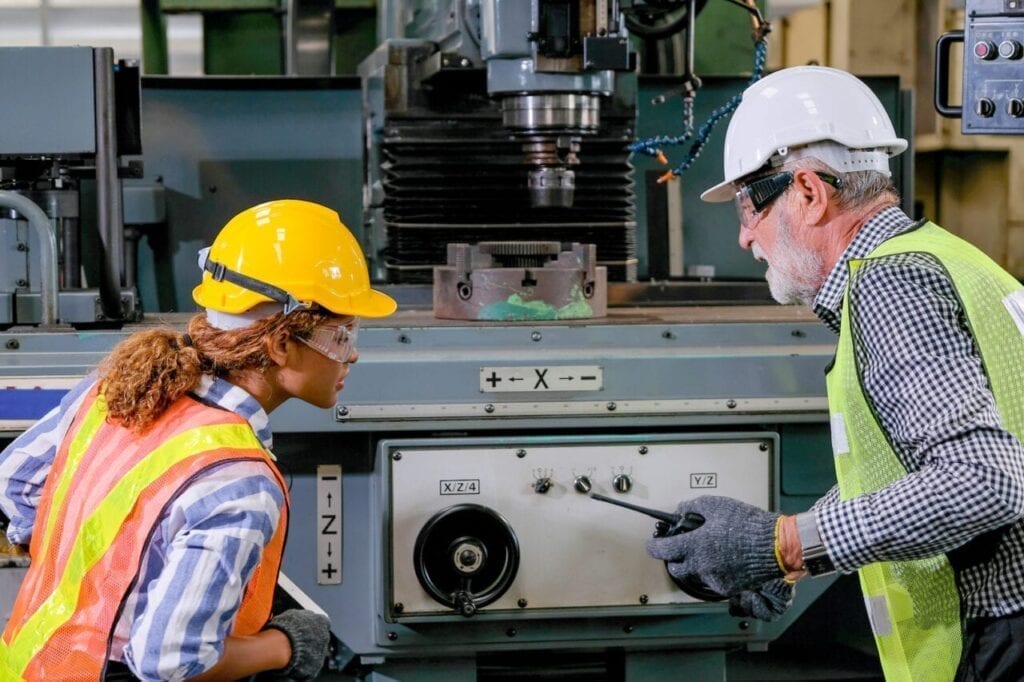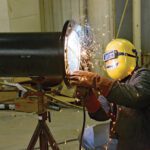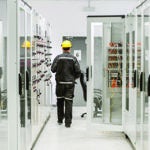The global energy sector, including utilities, is looking at a talent drain. As older workers retire, the competition to recruit younger workers to replace them has heated up.
The power generation industry today is more digitized, reliant on expertise in analyzing data and developing software. That means many workers who could move into positions at power plants also are among those coveted by the big technology companies. A recent study from National Grid in the UK found that the UK’s energy sector needs 400,000 skilled workers in the next few years to meet workforce demand in what it calls the “Net Zero Energy Workforce.” The study found 140,000 of those workers will be needed to replace those leaving the industry; the other 260,000 will be needed to fill new roles, including data analysts, machine learning experts, and those with knowledge of electric vehicles. New jobs linked to hydrogen and carbon capture also are being developed.
The U.S. power industry has long recognized the problem. The Dept. of Energy in an August 2006 report to Congress said a lack of trained lineworkers, and civil and mechanical engineers, would be problematic for utilities—and that was before the digital transformation of the industry took hold.
With competition for workers increasing, and with the power industry battling tech giants for the best talent, how can utilities and others in the power generation sector fill their workforce? How do power companies find the people to operate digital substations, advance artificial intelligence, and develop software?
Arjan Stam, director of systems operations at Alliander, an energy network developer and operator and a member of LF Energy’s Governing Board, and Dr. Shuli Goodman, executive director at LF Energy—an open source foundation focused on the power systems sector, hosted within The Linux Foundation—talked with POWER about how power generators should embrace new technology, and how that can attract new workers. They discussed how the energy industry can recruit tech talent by tapping into the coding community. They also said utilities should encourage new workers to participate in open source groups that will allow staff members to collaborate across industries, tap their creativity, and accelerate innovation in power generation.
POWER: What is the perception of utilities and power generators among the younger generation, especially those involved in technology?
Stam: We see that younger generations are much more in search of purpose in their professional lives. Since energy is on everyone’s agenda nowadays, younger people become more interested in the energy sector. That’s a societal change that helps. But also the transition itself introduces new complexities in developing the energy system that are new and challenging. Slowly, younger generations are discovering that nowadays the energy sector facilitates really interesting career opportunities.

Goodman: It is probably not on young people’s radar, but we [LF Energy] are seeking to change that. The hippest, coolest technology challenge facing humanity will be accelerating the transition to non-fossil fuel. A huge part of that is digital. This is a great time to study power systems and digitalization.
POWER: Utilities and power generators have embraced digitization and big data, but we continually hear that energy organizations have difficulty competing with Big Tech for the best and brightest talent. Is that a real situation, and if so, how can energy companies—utilities in particular—win the battle for tech-oriented workers?
Stam: The question suggests that there is only room for one specific solution to the energy challenges we face. I think there is no competition because we have different responsibilities and focus. The energy organizations do have a strong social responsibility. We as an energy organization need to take care of making energy easy accessible, affordable and available without discrimination. That is a tough challenge with all the change we are facing. I think Big Tech and the energy organizations are very complementary in bringing the energy transitions forward. My expectation is that we meet each other at the meter. The main focus points of energy organizations are connecting customers, system safety, and facilitating free energy markets.
The energy organization will provide grid stability, continuity and share information on available capacity. Behind the meter is the open environment where the customer makes his/her choices and uses services from Big Tech. When carefully designed both parties will have a throng responsibility in the future of energy.

Goodman: Big Tech is definitely recruiting talent from utilities. There is a great opportunity for tech companies to find their place in the power system networks of the future. In many ways, the networks are closer to internet or communication networks, and then managing congestion and stability.
POWER: How critical is the ongoing loss of institutional knowledge for the power generation industry?
Stam: Depends on how you look at this. When looking from the perspective of people transferring knowledge to people, it is indeed a cumbersome process to recruit skilled people in the volume we would require. Another perspective is digitization. An approach could be, like we do with Alliander, that we capture the knowledge of experienced people in algorithms. This way we are able to “document” the knowledge of our experienced people in an operational manner.
Goodman: This may be different than in Europe, but in the United States, as much as 50% of utility employees will reach retirement in the next 10 years. There is a tremendous amount of institutional knowledge that will be lost. And, to be frank, some of those executives and employees have stood in the way of progress. This is the time for elders to either lend a hand for the future and ensure a timely transition to a decarbonized power system, or step down.

We need a skilled, technical workforce. We also need a new generation that is willing to break with the past and design power systems in a new way. While we cannot avoid the laws of physics, we can consider whether to replicate a mechanistic view or a more network and systems-centric design pattern for how we transition to the future. This is a unique time in history. We do not need to carry any more from the past than is absolutely necessary. It is not clear whether the aging utility workforce is a curse or a blessing. I am leaning towards the latter.
POWER: What are some of the ways the power generation industry can become attractive to those looking for tech jobs, and how can utilities compete against companies such as Google and Amazon?
Stam: Typically DSOs (distribution system operators) operate a bit on the background because our role is facilitating transportation of energy. Being more explicit on our contribution to reduction of CO2 makes people more aware of the scale for our work and that there are large stakes to contribute to.
On the digitization area energy organizations are slowly opening and start using and contributing to open source projects. Working on open source projects helps attract talent.
In the transition from network operator to system operator a new kind of design complexity is introduced. It is no longer the ideas and design of the network operator that shapes the energy system of the future but also the contributions of generators, customers, providers of home energy management systems, municipalities, etc. A large stakeholder network to work on complex problems helps attract talent.
Goodman: Utilities should be mission-driven and serve at the behest of society. You can see how European utilities that are mission-driven, truly do think in terms of social benefit. This is attractive to anyone paying attention right now—whether you are young or mid-career.
POWER: Should power generators embrace open source groups, in order to attract the coding community, and as part of that join collaborations across industries?
Stam: Yes they should! For more than one reason. Open source collaboration is one of the methods to have access to highly skilled people. Because of joint development different perspectives on a topic are brought in the discussion, inherently leading to better solutions. Another reason for embracing open source is standardization. Creating a system of systems, which is what we are transforming to, requires voluminous data exchange and control information. This is only going to be successful with highly interoperable systems. In order to achieve a high level of interoperability, open standards are a de facto necessity. Another one is the cost of digitization. If we would quantify the amount of money needed to make our transformation in license cost, the transformation seemingly becomes unaffordable. Joining forces and sharing the burden of development with multiple parties can keep the cost down and the solutions being built fit better for their purpose better than anything else.
Goodman: Absolutely. Open source software is the plumbing that connects hardware and enables functionality. Open source is efficient and enables reuse, collective investment, and rapid innovation. Why would you say “no”? Probably, only because you don’t understand the role that open source has had in transforming industries.
POWER: What are the things power generators should stress—as an example, digital substations, and the transition to renewable energy and new asset management and control systems—to tech-oriented folks who are not aware of what the power sector has to offer them? What are these new jobs?
Stam: Virtualization. The power system is no longer about the physical assets but transforming to virtualization of the assets for control and analysis. This requires building complex models fit for purpose. Also, the physical assets in the field will be virtualized because of maintenance, flexibility, multi-vendor strategies, reduce wiring, etc.
Energy management. In the past the grid was assumed to be a “copper plate,”, and it has been designed as such, because there were no renewables and the user profiles were quite constant. So by design there was always enough energy, everywhere. Power generation no longer takes place at the high-voltage levels but is moving to the low-voltage levels. The grid is not designed for this change. So the limits of the grid become visible and the grid has to be protected from being damaged. So large-scale energy management has become a reality for the DSO.
Energy markets. From the past the DSO had little to do with energy markets; this was typically the domain of the TSO (transmission system operator) for balancing and congestion at the high-voltage levels. Since the DSO is now facing the same challenges of balancing, congestion management, etc., the DSO is also starting to use energy markets to solve the problems with the customers. Market strategies and implementation are new for the DSO.
System design. The transformation from a DNO (distribution network operator) to a DSO is quite challenging. Becoming a system operator requires that you are able to define the system, and also design and realize the system. New requirements for the system show that near-real time control of the energy management is required to operate the system properly. In terms of architecture and IT (information technology) this is a big change, an almost complete overhaul of the IT landscape for the core processes.
Customers (in any role). More than ever the DSO needs to be aware of the needs of the customers and become customer-focused. This is necessary to build the system since the customer is part of the system. Having operated in a highly regulated environment for decades where the customer has been associated with a grid connection, only we now have to understand the energy needs of the customer and help to realize those. This requires understanding of the intentions of the customers.
Goodman: The grid of the future will not be a grid at all. Rather, it will be a huge network that choreographs supply and demand to maintain balance of the system as a whole. This is a huge challenge where the design profoundly impacts life as we know it. Power systems are often referred to as “infrastructure.” As we shift our infrastructure from centralized to distributed it will, in effect, structurally encourage democratization by shifting energy and power to individuals and communities. The technical challenge of decarbonization of our economies will drive innovation at scales humans have barely considered. It is an exciting time to be a power systems engineer.
—Darrell Proctor is associate editor for POWER (@POWERmagazine).










